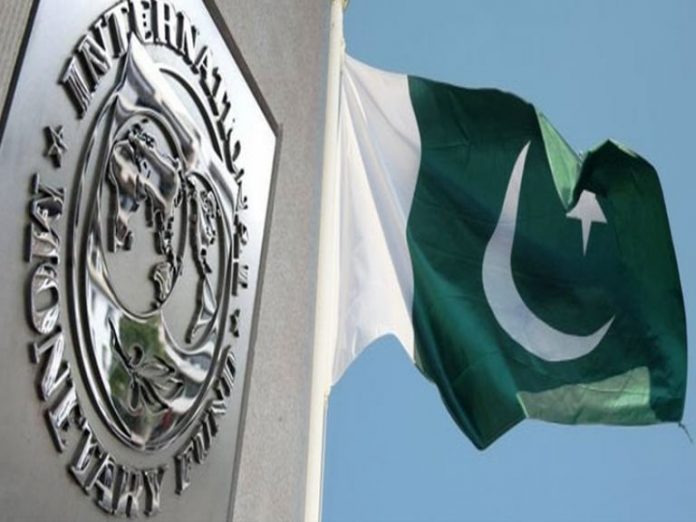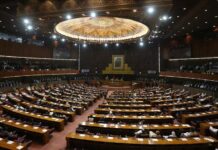
LAHORE: International Monetary Fund (IMF) on Thursday released its post-program monitoring report predicting gross external financing needs are projected to touch $27 billion by next financial year.
Its report highlighted risks to Pakistan’s debt sustainability have risen since the Article IV consultation in June 2017 and increase in borrowings would contribute to external debt touching $103.4 billion by June 2019, predicted the IMF.
The Washington-based lender stated Pakistan had taken strides in improving its debt profile in last few years, but the public and publicly guaranteed debt remained around 70 percent of GDP in FY 2016-17 but is expected to slightly fall over the medium-term.
IMF said Pakistan’s elevated debt level in contrast to several emerging markets indicated fiscal imbalances under “relatively benign real sector assumptions” read the report.
It highlighted the baseline debt path also crossed the limit on public debt levels set forth in the revised Fiscal Responsibility and Debt Limitation Act (FRDLA). The report stated the gross financing needs are estimated to stay higher throughout the forecast period.
IMF advised for improving public debt sustainability and building sufficient fiscal buffers, sustained fiscal consolidation was required. The report pinpointed external debt remains sustainable but is susceptible to risks as external borrowing is predicted to rise and forex reserves will keep their downward slide due to present financial policies.
Pakistan’s public debt and publicly guaranteed debt at end of FY 2016-17 touched 69.7 percent of GDP reaching around 70 percent of FY 2015-16, said the report. Also, public debt leaving guarantees aside was recorded at 67 percent of GDP.
As per the debt sustainability analysis (DSA) in IMF’s report, debt levels remained higher than anticipated during the 2017 Article-IV consultation. The actual fiscal deficit was 1.3 percent higher than that predicted by Article-IV projects because of revenue underperformance and a major increase in development spending.
The report noted net-public debt also rose to roughly 62 percent of GDP and 30 percent of total public debt was foreign currency denominated.
As per IMF’s projections, public and publicly guaranteed debt would touch around 70 percent of GDP by 2020 under the baseline and public debt leaving guarantees aside is forecast to remain roughly 66 to 67 percent of GDP.
Due to lack of consolidation measures, the report said the fiscal deficit leaving grants aside was expected to stay close to 6 percent of GDP in the medium term, contributing to increase in debt levels.
IMF cautioned nasty shocks especially to economic and primary balance could contribute to public debt ratio exceeding above the 70 percent mark.
Contingent liabilities arising from restructuring of loss bleeding public-sector enterprises (PSEs) would present additional fiscal risks, the IMF warned.
The IMF projected gross financing needs to cross 30 percent of GDP against 29 percent in FY 2016-17, largely accounted for by domestic loan amortization.
The report although said improvements in debt profile were witnessed in last few years which contributed to” moderate shares of short-term and foreign exchange-denominated debt that sit between the lower and upper early warning thresholds,” evolving into high gross financing needs, which could cause potential rollover risk.
The IMF suggested toughening of fiscal consolidation to improve debt dynamics, build adequate fiscal buffers and continuously attain legally mandated debt targets.
It added fiscal tightening was a necessity to preserve and improve debt sustainability due to risks posed by high levels of public debt and gross financing needs.
Also, the post-programme monitoring report stressed on the seriousness of strong consolidation efforts to protect reliability of fiscal responsibility framework due to deficiency of major policy effort.
And the report said, “the projected public debt trajectory sits higher than that stipulated in the revised FRDL Act with a limit of 60 percent of GDP on net general government debt until FY 2017/18 and a gradual transition toward 50 percent of GDP over a 15-year period.”
The external DSA highlighted forecast path for external debt was maintainable but prone to growing risks. The gross external debt as a percentage of GDP which had been falling till 2015 is expected to grow and reach a high of 32 percent of GDP by 2021.
Furthermore, bound and stress tests were indicative that external debt to GDP ratio would be impacted by detrimental shocks.
External debt ratio would remain susceptible to current account and exchange rate disturbances and would only cross 45 percent due to real depreciation shock scenario, said IMF.
The projected downward slide in foreign exchange reserves, increase in gross external financing would add to the external risks and would rise to 9.9 percent of GDP by 2023 in comparison to 7.1 percent recorded in FY 2016-17.






